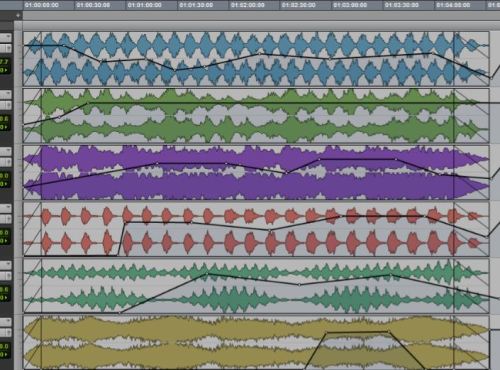We knew that getting the right music for Astroneer was going to be a challenge since our artists set a high bar with a striking visual style. Creating an aural soundscape to match the visual landscapes is a tall order, and fierce debates were had on the direction to take!
Our goal with the music is to create something that was clean and clear, but also support the setting of space. The music also needs to enhance the idea that the player is building something while exploring uncharted territory.
Finding that specific style of music started with us listening to hours upon hours of music that might fit the themes of Astroneer. Some of those that stuck out were Jon Hopkins, Brian Eno, Harold Budd, Clint Mansell, and Jóhann Jóhannsson. All of those artists were great, but the one we kept coming back to was Stars Of the Lid, specifically their album “And Their Refinement of the Decline.” With those artists as our barometer we were able to search for the right composer that could bring Astroneer’s music into reality. That composer turned out to be Rutger Zuydervelt(aka Machinefabriek.) Rutger is an incredibly talented musician from the Netherlands that combines elements of ambient, drone, and minimalist music that works exceptionally well for the backdrop of Astroneer’s visuals.
Working with Rutger is absolute pleasure and the quality of his work will speak for itself when players experience Astroneer. His music helps provide a bearing for the listener and when heard, transports the player onto an uncharted world. Below you can find one music cue that will exist in the game.
MUSIC MADE FROM HUNDREDS OF PIECES
Astroneer’s music is one of the most important storytelling tools for us, and leveraging that power is critical for creating an emotional impact that the player will remember. Because the game is procedurally generated and non-linear, the music has to be intelligent. One of the most basic ways to play video game music is just back to back stereo tracks: when one song ends another one begins. Astroneer’s music is smarter than that and will trigger based on game states that are relevant to the events that are happening to the player. For example, if an Astroneer lands on a new planet, we’d want to play music for that special moment.
This is nothing new. Most AAA video games do this, but unfortunately doesn’t happen enough with indie games. The second way the music interacts with the player is that we separate each piece of music into six layers of music. When Rutger works on each track, he designs each piece to be broken into multiple layers that could work individually or as a group. This allows the game to mix the music live based on conditions that the player is experiencing.
A piece of music could be playing, but because the player has done something positive while the song is going, one of the layers becomes more prevalent in the mix. This small change will subtly highlight the fact that the player has achieved something. None of this will be spelled out for the listener; it isn’t suppose to be obvious. The experience will be indirect and never take the player out of the experience at hand. There will be no bombastic drums or blaring trumpets, just subtle waves of emotion that enhance a player’s experience.
One other benefit to this system is that in each piece of music Rutger has created a dissonant layer that is only meant to be heard when something bad is occurring to the user. Exploring planets and asteroids isn’t always a safe endeavor; this dissonant layer is intended to transition the various moods that occur while playing Astroneer. For example, a dissonant layer will fade in when oxygen / power reserves are past a certain threshold and will get louder as they get close to depletion. There will be visuals and sound effects that accompany this situation, but before any of those occur, the player will be warned in advance by the music. Not all players will realize it, but an advanced player will discover that subtle changes in music give feedback on certain issues that are affecting a player.
Shown in the example below, you have six tracks that make up one song that could be triggered while you play Astroneer. The bottom most layer represents the dissonant distorted track that plays only on negative situations. The top five tracks make up the bulk of a typical music cue that will be heard in the game. Because each piece of music is made up of 6 dynamic layers, all of the volumes are mixed randomly and are mixed by specific game states Because of this it is very likely that a player will hear a unique mix that may only happen one time ever.

The lines on the waveforms represent the amplitude of the specific track.
GOING FORWARD…
That was just a brief overview of how music will exist in the initial release of Astroneer. Some time in the future I’ll go into much greater detail on how the game mixes and triggers the in-game music.
Just like the rest of the game, Astroneer’s music is meant to evolve and grow overtime. As we progress through Steam Early Access, the music will become more advanced and there will be more of it!
-Riley
Astroneer will be available on Steam Early Access this year for Windows and Mac OS.
You can follow Astroneer on Twitter and Facebook, where we are actively sharing news and media content about the game.
If you’d like to send us an email or sign up for our Newsletter please visit our website.



More Astroneer Content in These Places